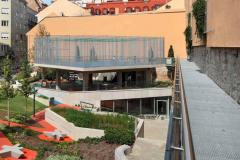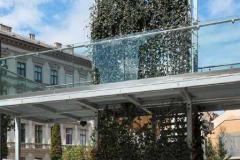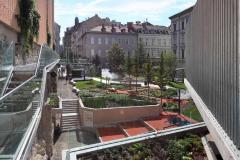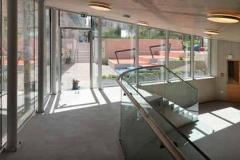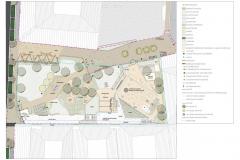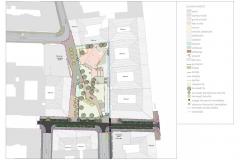Beyond the Ruins
Bástya-park, Budapest
Architects: Lajos Koszorú, Bálint Koszorú
Text: Miklós Okrutay
Photos: József Hajdú
Up until the end of the 18th century, the medieval city wall of Pest marked the boundaries of the capital a bold gesture. It was only from the 1770s on that residential buildings were permitted, and the gateways and bastions at the end of the main roads were demolished. In Pál Királyi Street, where the town wall had stood, several adjoining plots of land became vacant over time to be used as car parks for a long time. Later, a small playground was wedged into this site. The primary message of Bástya-park („Bastion Park), which was opened to the public in the spring of 2022, is precisely the way it brings the medieval city wall into focus with elementary dynamics.
Able to evoke the romance of a medieval castle, the wall evolves into the primary content. This is primarily facilitated by two basic means of architecture. On the one hand, one of the most exciting detail is the way you can access the reconstructed level of the former machicolation and play the role of an armoured defender of the castle hiding behind the portholes of the cornice. On the other hand, it also manages to show the full scale and dimensions of what it once had been back in the Middle Ages. From the surrounding street level, a playfully constructed winding path leads down to the medieval ground level with a red rubber pavement evoking the atmosphere of a slag-covered pavement. In the bays of the meandering path there is an extraordinary abundance of planted vegetation. In an area of just a few blocks, the intensity of functions seems quite an extraordinary phenomenon, yet, along with the spectacular display of the ruins of the city walls, it impresses us as if every single detail has found its own special place here.
Architecture, landscape, traffic: Lajos Koszorú, Bálint Koszorú, Dzsenifer Ulbert, Dóra Magyarosi, Mátyás Attila Ágó, Ádám Kétszeri, András Házi, László Major
Structures: István Kenese, Gábor Monostori
Concept: Város-Teampannon Ltd, Objekt Ltd., CAN Architects Studio


